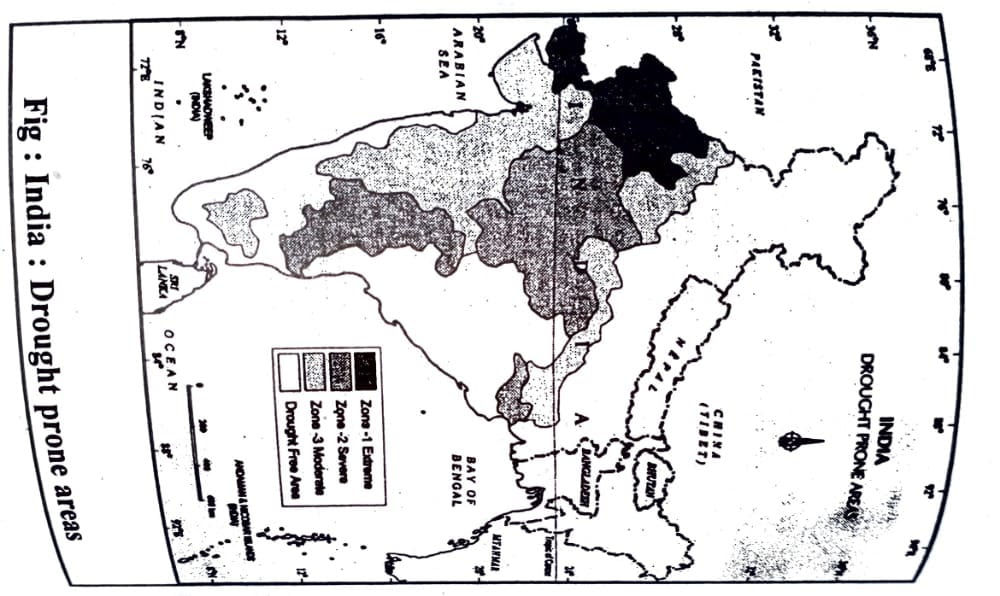Class 11 Geography Chapter 23 Natural Hazards and Disasters The answer to each chapter is provided in the list so that you can easily browse throughout different chapters SCERT Class 11 Geography Chapter 23 Natural Hazards and Disasters and select need one.
Class 11 Geography Chapter 23 Natural Hazards and Disasters
Also, you can read the SCERT book online in these sections Solutions by Expert Teachers as per SCERT (CBSE) Book guidelines. These solutions are part of SCERT All Subject Solutions. Here we have given Assam Board/NCERT Class 11 Geography Chapter 23 Natural Hazards and Disasters Solutions for All Subject, You can practice these here…
Natural Hazards and Disasters
Chapter: 23
PART-2
GEOGRAPHY
TEXTUAL QUESTION & ANSWER
Q.1.Which one of the following states of India experiences flood frequently?
(i) Bihar
(ii) West Bengal
(iii) Assam
(iv) Uttar Pradesh
Ans: (iii) Assam
Q.2.In which of the following districts of Uttarakhand did the Malpa landslide disaster take place?
(i) Bageshwar
(ii) Champawat
(iii) Almora
(iv) Pithoragarh
Ans: (iv) Pithoragarh.
Q.3.Which one of the following states receives floods in the winter months?
(i) Assam
(ii) West Bengal
(iii) Kerala
(iv) Tamil Nadu
Ans: (iv) Tamil Nadu.
Q.4.In which of the following rivers is the Majuli River Island situated?
(i) Ganga
(ii) Brahmaputra
(iii) Godavari
(iv) Indus
Ans: (ii) Brahmaputra
Q.5.Under which types of natural hazards do blizzards come?
(i) Atmospheric
(ii) Aquatic
(iii) Terrestrial
(iv) Biological
Ans: (i) Atmospheric.
Answer the following questions in less than 30 words
Q.1. When can a hazard become a disaster?
Ans: A hazard becomes a disaster when its magnitude of destruction and damage caused by hazard is very high.
Q.2. Why are there more earthquakes in the Himalayas and in the North Eastern Region of India?
Ans: From the theory of Plate Tectonics’ we come to know that in the plate boundaries more. earthquakes occur, because plate boundaries are areas of convergence and divergence forces.In the Himalayas and North eastern region there is a plate boundary of Indian Plate and Eurasian plate.That is why,this part of earth surface receives more earthquakes.
Q.3. What are the basic requirements for the formation of a cyclone?
Ans: The Basic requirements for the formation of cyclone are:
(a) Large and continuous supply of warm and moist air that can release enormous latent heat.
(b) Strong coriolis force.
(c) Unstable condition through the troposphere that creates local disturbances around which a cyclone develops.
(d) Absence of strong vertical wind wedge.
Q.4. How are the floods in Eastern India different from the ones Western India?
Ans: The floods in Eastern India are frequent,more destructive and cover a very wide area.But the floods in western India are less frequent, less destructive and cover less area.
Q.5. Why are there more droughts in central and western India?
Ans: In central and western India, droughts are more common, because of the following reasons:
(a) The monsoon is very weak in these areas.
(b) These areas are far away from the water bodies like
Arabian sea Bay of Bengal.
(c) Less forest cover in such areas.
Answer the following questions in not more than 125 words
Q.1. Identify the landslide prone regions of India and suggest some measures to mitigate the disasters caused by these.
Ans: Like other disasters it is very difficult to define in a precise and statement and generalize the occurrence and behaviour of a landslide. On the basis of past experiences,frequency and certain casual relationships with the controlling factors like geology, geomorphic agents,slope, land- use vegetation cover and human activities, India has been divided into the following landslide prone areas.
(a) Very High Vulnerability zone: It includes highly Unstable and young mountainous areas in the country such as the Himalayas and Andaman and Nicobar Island, Western Ghats and Nilgries, the North-eastern Regions.
(b) High Vulnerability Zone: All the Himalayan states and North-Eastern Regions except the plains of Assam.
(c) Moderate to low Vulnerability Zone: Trans Himalayan areas, Aravali, rain shadow Areas of western and Eastern Ghats,Deccan plateau etc.are the areas of low Vulnerability Zone.
(d) Other areas: Rajasthan,Haryana, Uttar Pradesh, Bihar, West Bengal,Assam included in the other areas.
Mitigation:
(a) Restriction on the construction and other developmental activities such as roads and dams in the landslide areas.
(b) Limiting agriculture to valleys and areas with moderate slopes.
(c) Control on the development of large settlements in the high Vulnerability Zones should be enforced.
(d) Shifting cultivation must be controlled or stopped in sloppy areas.
| Sl. No. | CONTENTS |
| Chapter 1 | Geography As A Discipline |
| Chapter 2 | The Origin and Evolution of the Earth |
| Chapter 3 | Interior of the Earth |
| Chapter 4 | Distribution of Oceans And Continents |
| Chapter 5 | Minerals and Rocks |
| Chapter 6 | Geomorphic Processes |
| Chapter 7 | Landforms and Their Evolution |
| Chapter 8 | Composition and Structure of Atmosphere |
| Chapter 9 | Solar Radiation, Heat balance, and Temperature |
| Chapter 10 | Atmospheric Circulation and Weather Systems |
| Chapter 11 | Water in the Atmosphere |
| Chapter 12 | World Climate and Climate Change |
| Chapter 13 | Water (Oceans) |
| Chapter 14 | Movements of Ocean Water |
| Chapter 15 | Life on the Earth |
| Chapter 16 | Biodiversity And Conservation |
| Chapter 17 | Indian Location |
| Chapter 18 | Structure and Physiography |
| Chapter 19 | Drainage System |
| Chapter 20 | Climate |
| Chapter 21 | Natural Vegetation |
| Chapter 22 | Soils |
| Chapter 23 | Natural Hazards and Disasters |
Q.2. What is vulnerability? Divide India into natural disaster vulnerability zones based on droughts and suggest some mitigation measures.
Ans: Vulnerability is the potential for loss in which an individual or community or a place can be affected due to a disaster.
On the basis of severity of droughts,India can be divided into the following regions:
(a) Extreme Drought affected areas: Most parts of Rajasthan, parts of Gujarat fall in this category.In these areas the average annual rainfall receives less than 90cm.
(b) Severe Drought prone areas: Parts of eastern Rajasthan, parts of Madhya Pradesh eastern parts of Maharashtra, parts of Andhra Pradesh, Karnataka plateau, Tamil Nadu, Jharkhand and parts of Orissa falls in this zone.
(c) Moderate Drought affected areas: Northern palts of Rajasthan, Haryana, Southern Uttar Pradesh , Parts of Gujarat, Maharashtra interior Karnataka are the areas of moderate drought-prone areas.

Mitigation: Droughts situations can be minimized through-
(a) Inter linking river channels.
(b) By constructing reservoirs and dams for future uses of water.
(c) Large scale afforestation programme, which may give vegetal cover.
(d) Stop overgrazing.
(e) Destruction of forest particularly near drought prone areas must be stopped.
Q.3.When can developmental activities become the cause of disasters?
Ans: Many times and many disasters are also caused due to the various development activities of human being.Some of such disasters magnitude are unbelievably more than the natural disasters.
The following are the examples of disasters which are caused human activities:
(a) Bhopal Gas tragedy.
(b) Chernobyl nuclear disaster and war.
(c) Release of chlorofluorocarbons (CFs) and increase of green in the atmosphere.
(d) Environmental pollution etc.are some national and world wide disasters created by human being.Besides these some other disasters caused due to the economic development of man are-
(e) Landslides
(f) Floods
(g) Unscientific land use
(h) Unplanning construction brings various disasters to human beings.

Hi, I’m Dev Kirtonia, Founder & CEO of Dev Library. A website that provides all SCERT, NCERT 3 to 12, and BA, B.com, B.Sc, and Computer Science with Post Graduate Notes & Suggestions, Novel, eBooks, Biography, Quotes, Study Materials, and more.



